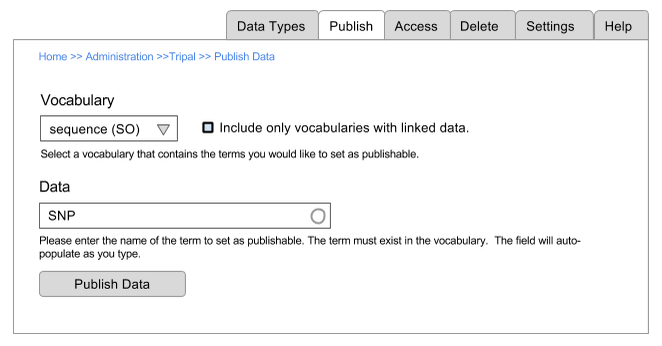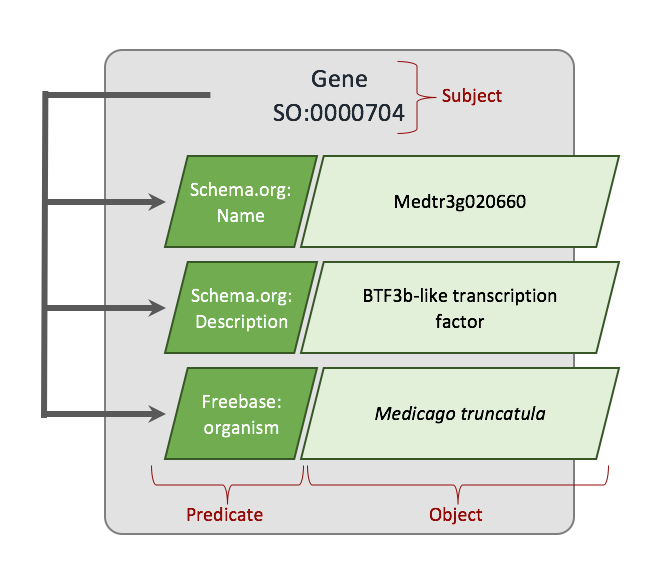
Ontology Driven Design
Controlled vocbularies and ontologies become a central organizing feature of Tripal 3.0 ensuring that biological rather than chado-centric terminology is used. This makes Tripal more comfortable to the biologist for searching and browsing, as well as, more intuitive to the site administrator. Tripal version 3.0 will use Drupal Entities to create ontology-based pages that provide content unique to genes, analyses, maps, libraries, germplasm, publications, etc.
Ease of Customization
Because every biological data type published by Tripal 3.0 is a Drupal Entity, the Drupal web interface allows site administrators to customize data entry forms and display pages. While Drupal core allows you to rearrange fields, customize entry widgets and basic display, contributed modules such as Display Suite and Panels provide complete control over layout allowing you to arrange fields into tables, multiple columns, accordion displays, etc. This greatly reduces the need to customize PHP templates and leads to less coding!
Chado and Beyond
Chado remains the primary database back-end for Tripal and is the ideal location to store most of your biological data. However, the need has arisen for making data stored in other ways (such as BAM, VCF or NoSQL options) also available through your Tripal site. Drupal Entities allow you to add new custom "fields" to your pages and thus aggregate data from Chado with other storage formats. The Drupal and Tripal API provides the programmatic access to create these field and share them with others.

Simplified Administration
Tripal 3.0 will have a simplified administrative interface for all biological content. Your data in Chado is already categorized by ontology terms, therefore, administrators can simply choose to publish the terms defining the data you would like to share. Tripal will publish all data of the specified type, and automatically associate ancillary data linked to it within Chado. Access to private data can be controlled at a granular level such that subsets of data can specified and group permissions set.
Drupal Search API Integration
Since Tripal 3.0 publishes all of your data as entities, it benefits from built-in Drupal Search API integration. This means that all the fields displayed on your Tripal pages will be indexed for searching through a user-friendly, site-wide search box. Furthermore, the Search API supports both Apache Solr and Elastic Search either of which vastly improves performance and provides faceted search allowing users to fine-tune their search results.

The Semantic Web
All the data presented by Tripal 3.0 will be fully described using the subject > predicate > object tuples required by the Semantic Web. This ensures your data is described in such a way as to be exchanged between communities. Drupal RDFa and XHTML will be used to embed the semantic web tuples in your pages to allow advanced search engines to understand the data presented.
Web Services
All data presented on a page in Tripal 3.0 becomes available via Web services. RESTful Web services will be encoded in JSON-LD which provides an intuitive interface for consumers of web services familiar with JSON. JSON-LD also provides the tuples so important for the semantic web ensuring your content is fully described.
Support for all Data Types
This change in Tripal 3.0 to an ontology-centric design will ensure that if your data is described by an ontology term, even a custom in-house term, you can create pages and attach data. This provides even more flexibility to site administrators!
Million Dollar Question: Backwards Compatibility?
As always, backwards compatibility is a major factor taken into the design of any changes to Tripal. With the change from Nodes to Entities a certain amount of backwards compatibility is lost. Specifically any customizations made to node types, such as custom form elements, will need refactoring. That said, the entire Tripal API will remain backwards compatible and an effort is being made to ensure your custom templates will still work. This, coupled with a mostly automated upgrade path should ease your adoption of Tripal 3.0.
One final consideration is that, although your custom page templates may still work in Tripal 3.0, we encourage you to update your pages to use the new user-interface as this will ensure a more seamless upgrade to Dupal 8. This is due to the fact that Drupal 8 uses the new Twig theme system which requires a complete a rewrite of your current templates.